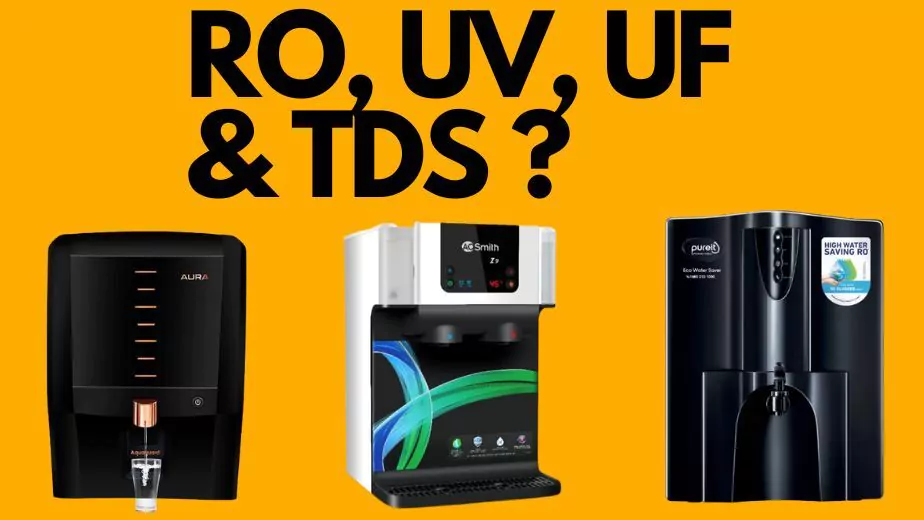Discover the Real RO, UV, UF, TDS meaning

Water is an essential resource that is required for human survival. However, due to the increasing pollution levels and environmental degradation, the quality of water has been significantly impacted. Waterborne diseases are on the rise, and millions of people worldwide suffer from illnesses caused by contaminated water. This is where water treatment technologies come into play, with RO, UV, UF, and TDS being some of the most commonly used technologies for water purification.
In this blog, we will delve into the meaning of these technologies and understand how they work to provide safe and clean drinking water.
1 Reverse Osmosis (RO)
Reverse Osmosis is a water purification process that is used to remove dissolved salts, minerals, and other impurities from water. It uses a semi-permeable membrane to separate the impurities from the water. The membrane used in this process has very small pores, which allow only water molecules to pass through while blocking the impurities.
The process of Reverse Osmosis involves forcing water through the membrane at high pressure. The impurities in the water are left behind, and only clean water passes through the membrane. The impurities that are removed through RO include dissolved solids, bacteria, viruses, and other contaminants.
RO is commonly used in households, industries, and even in water treatment plants. The technology is particularly useful in areas where the water supply is contaminated with high levels of dissolved salts, such as in coastal areas where seawater intrusion is a common problem.
How does the Reverse Osmosis (RO) process work?
The RO process involves several stages:
- Pre-filtration: The water is first passed through a sediment filter to remove large particles and debris. This is necessary to prevent damage to the RO membrane and to improve the efficiency of the process.
- Pressurisation: The pre-filtered water is then pressurised to force it through the semi-permeable membrane. The pressure is typically between 40-70 psi.
- Separation: As the water passes through the membrane, the impurities and contaminants are trapped and left behind, while the purified water passes through to the other side.
- Post-filtration: The purified water is then passed through another activated carbon filter to remove any remaining odors, tastes, or residual impurities.
The reverse osmosis process is highly effective in removing a wide range of contaminants, including bacteria, viruses, pesticides, chemicals, and heavy metals. It can remove up to 99% of impurities, depending on the membrane quality and the design of the system.
RO systems are widely used for both residential and industrial water purification applications and are often combined with other treatment processes to ensure the highest quality of water
2 Ultraviolet (UV)
Ultraviolet is a water treatment process that is used to kill bacteria, viruses, and other microorganisms in water. It works by exposing the water to ultraviolet light, which disrupts the DNA of the microorganisms and renders them harmless.
UV is particularly effective in killing waterborne pathogens such as E. coli, salmonella, and other bacteria and viruses. The technology is often used in conjunction with other water treatment technologies, such as RO or UF, to provide complete water purification.
UV is a popular water treatment technology in households and industries, especially in areas where the water supply is prone to contamination. It is also widely used in water treatment plants as a primary disinfection method.
How does the Ultraviolet (UV) process work?
The UV purification process typically involves the following steps:
Step – 1: Water is passed through a UV chamber that contains one or more UV lamps. The lamps emit UV-C radiation, which has a wavelength of 254 nanometers (nm), the optimal wavelength for killing microorganisms.
Step – 2: As the water flows inside the chamber, the UV-C radiation penetrates the cell walls of any microorganisms present in the water, disrupting their DNA and RNA.
Step – 3: The damaged microorganisms are then unable to reproduce or cause infection and are either killed outright or rendered harmless.
Step – 4: The purified water is then collected for use.
It’s important to note that UV purification does not remove other contaminants from the water, such as chemicals, minerals, or sediment. It only kills or inactivates microorganisms. As a result, UV purification is often used in combination with other water treatment methods, such as sediment filtration, activated carbon filtration, or reverse osmosis, to provide a complete water treatment solution.
3 Ultrafiltration (UF)
Ultrafiltration is a water treatment process that utilises a membrane to remove suspended solids, bacteria, and other impurities from water. It is similar to RO, but the membrane used in UF has larger pores, allowing more impurities to pass through.
The process of Ultrafiltration involves forcing water through the membrane at a lower pressure compared to RO. The impurities in the water are left behind, and only clean water passes through the membrane. The impurities that are removed through UF include suspended solids, bacteria, and other contaminants.
UF is commonly used in households, industries, and water treatment plants. It is particularly useful in areas where the water supply is contaminated with high levels of suspended solids or bacteria.
How does the Ultrafiltration (UF) process work?
The UF process typically consists of the following steps:
- Pre-treatment: The water is first screened to remove larger particles and debris, such as leaves and branches.
- Filtration: The water is then pumped with the help of a UF membrane under pressure. As the water passes through the membrane, suspended solids, bacteria, and other particles are trapped by the membrane and filtered out.
- Backwashing: Periodically, the UF membrane is back-washed to remove any accumulated particles and restore the membrane’s permeability.
- Disinfection: After the UF process, the water is typically disinfected with a chemical or physical process, such as chlorination, to kill any remaining bacteria or viruses.
The UF process is effective in removing suspended solids, bacteria, and other particles from water. It is commonly used in water treatment systems for drinking water, industrial process water, and wastewater treatment. The UF process is often combined with other water treatment technologies, such as reverse osmosis or nanofiltration, to achieve higher levels of purification.
4 Total Dissolved Solids (TDS)
Total Dissolved Solids is a measure of the amount of dissolved solids in water. It includes salts, minerals, metals, and other substances that are dissolved in water. TDS is measured in parts per million (ppm) or milligrams per litre (mg/L) and is often used as an indicator of water quality.
The level of TDS in water depends on various factors, such as the geology of the region, the source of water, and the level of industrialisation. High TDS levels in water can cause health problems and affect the taste and appearance of water.
TDS can be measured using a TDS meter, which measures the electrical conductivity of the water. The meter then calculates the TDS level by converting the electrical conductivity into parts per million (ppm) or milligrams per litre (mg/L).
TDS is a critical parameter in water purification and treatment. It is often used to determine the effectiveness of water treatment technologies such as RO, UV, and UF. TDS can also be used as an indicator of water quality, with higher TDS levels indicating poor water quality.
Water purification systems use various methods to remove TDS from water. Some additional methods include:
- Distillation: This method involves boiling water and collecting the steam that is produced. The steam is then condensed back into the water, leaving behind the dissolved solids, which are removed from the system.
- Ion Exchange: This method involves passing water through a resin bed that is charged with ions of the opposite charge to the dissolved solids. The dissolved solids are exchanged with the ions on the resin bed, leaving behind pure water.
- Activated Carbon Filtration: This method involves passing water through activated carbon, which attracts and absorbs dissolved solids, including organic compounds.
5 Wrapping Up
Water treatment technologies are crucial in ensuring that we have clean and safe drinking water. With the increasing levels of pollution and environmental degradation, the quality of water has been significantly impacted, leading to a rise in waterborne diseases. Reverse Osmosis, Ultraviolet, and Ultrafiltration are some of the most commonly used water treatment technologies. Reverse Osmosis is useful in areas where the water supply is contaminated due to high levels of dissolved salts. Ultraviolet is effective in killing viruses, bacteria, and other microorganisms, while Ultrafiltration is suitable for areas where the water supply is contaminated due to high levels of suspended solids or bacteria.
It is necessary to remember that these technologies are often used in combination with other water treatment methods to provide a complete water treatment solution. Overall, the use of water treatment technologies is crucial in ensuring that we have access to clean and safe drinking water.
Community Q&A
About This Article
This article has been viewed 608 times.



